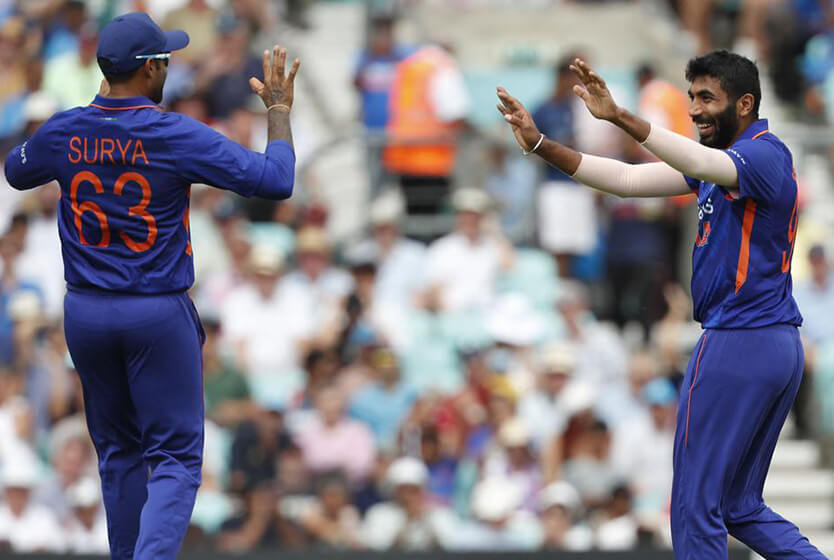
How Can Pakistan Get the Best Out of Haris Rauf in the T20 World Cup?
The fast-bowler from Rawalpindi is in Pakistan’s squad for the T20 World Cup and is likely to play a crucial role.
Haris Rauf is one of the quickest fast bowlers on the T20 circuit and one of the mainstays of Pakistan’s T20 team. However, his place in the squad for the T20 World Cup has been questioned by many, with the most common criticism being that he leaks too many runs.
Recent Dip In Form
The speedster has been heavily criticized for conceding too many runs. However, is that due to him being poor in general, or is it due to him being misused? Haris Rauf has the worst economy rate in the Powerplay among Pakistanis. This suggests that due to his relatively poor control with the new ball, captains should avoid utilizing him in the Powerplay.
Worst Powerplay economy in T20Is among Pakistani bowlers (min. 50 balls bowled)
| Bowler | Overs | Wickets | Avg | SR | Econ |
| Haris Rauf | 18 | 2 | 95.5 | 54.0 | 10.6 |
| Wahab Riaz | 15 | 3 | 46.7 | 30.0 | 9.3 |
| Junaid Khan | 10 | 1 | 93.0 | 60.0 | 9.3 |
| Usman Shinwari | 20 | 2 | 84.5 | 60.0 | 8.5 |
| Mohammad Hasnain | 17 | 5 | 28.4 | 20.4 | 8.4 |
Haris Rauf has the worst average among these bowlers as well, showing that he isn’t particularly adept at picking up wickets either. Despite that, he has bowled the third-most balls in the Powerplay for Pakistan since 2019. Only Imad Wasim and Shaheen Shah Afridi have bowled more.
However, the pacer has been improving with the new ball in the National T20 Cups. He should bowl with the new ball in the domestic system, as this is where he has the opportunity to improve his new ball skills. Haris has always had the skill to swing the new ball away from right-handed batters, which was on show during his maiden List A tournament in 2019. What he needs to work on is his control of line and length with the new ball.
Alternative New-Ball Options
For Pakistan, there are a lot of potential partners for Shaheen Shah Afridi, who can share the new ball during the T20 World Cup.
Pakistan T20 World Cup Bowlers in the Powerplay (T20s Since 2019)
| Bowler | Overs | Wkts | Avg | SR | Econ |
| Hasan Ali | 86 | 26 | 24.2 | 19.8 | 7.31 |
| Mohammad Nawaz | 66 | 19 | 25.9 | 20.8 | 7.47 |
| Imad Wasim | 141.5 | 29 | 33.5 | 29.3 | 6.85 |
| Mohammad Hafeez | 48 | 8 | 45.0 | 36.0 | 7.50 |
| Mohammad Wasim | 18.2 | 3 | 45.7 | 36.7 | 7.47 |
So among the bowling options in this squad, Pakistan can use either of the left-arm spin options on pitches where spinners do regularly open the bowling (UAE). If the opposite team has left-hand opening batters, Mohammad Hafeez can be handy as well.
Thus, it’s not necessary to utilize Haris Rauf in the Powerplay in this upcoming T20 World Cup.
How To Use Haris Rauf in the World Cup
Haris Rauf is one of the standout death bowlers in the world in recent times. While his numbers aren’t quite at the level of a Jasprit Bumrah or Mustafizur Rahman, he has been above average in an era where batsmen have been looking to utilize the death overs to the maximum.
Best T20 Economy Rates at the Death (Since 2019, min 70 overs)
| Bowler | Econ |
| Jasprit Bumrah | 8.01 |
| Mustafizur Rahman | 8.21 |
| DJ Bravo | 8.39 |
| Chris Morris | 8.66 |
| Shaheen Shah Afridi | 8.95 |
| Haris Rauf | 8.96 |
However, the speedster cannot bowl all four of his overs at the death of an innings. So the question arises: What is the optimal way to use him?
Pakistan T20 World Cup Bowlers in the Middle Overs (T20s Since 2019)
| Bowler | Overs | Wkts | Avg | SR | Eco |
| Imad Wasim | 198 | 55 | 24.2 | 21.6 | 6.73 |
| Hasan Ali | 60 | 18 | 24.8 | 20.0 | 7.45 |
| Mohammad Hafeez | 81.5 | 21 | 25.2 | 23.4 | 6.48 |
| Shadab Khan | 295 | 80 | 28.8 | 22.1 | 7.82 |
| Haris Rauf | 115.5 | 31 | 28.8 | 22.4 | 7.72 |
| Mohammad Nawaz | 156 | 40 | 31.1 | 23.4 | 7.97 |
| Shaheen Shah Afridi | 41 | 11 | 33.0 | 22.4 | 8.85 |
| Mohammad Wasim | 29 | 6 | 44.8 | 29.0 | 9.28 |
Hasan Ali and Haris Rauf stand out among the pacers that Pakistan generally utilizes in the middle overs. Both have distinct styles, with Hasan relying more on cutters and change-ups to stop the opposition in their tracks. On the other hand, Haris tends to bowl shorter lengths, similar to an enforcer role.
Death Overs Bowling
According to CricViz, a well-executed yorker goes at around 6 to 6.5 runs per over. However, a failed yorker, which normally becomes a half-volley or a full-toss, becomes one of the easiest deliveries to face and thus goes at more than 10 runs per over. Thus, going for yorker after yorker is fraught with risk. On average, a pacer at the death nails around 1 in 3 yorkers, and the margin for error is tiny.
Thus, it’s imperative that a bowler has other variations up his sleeve. At the same time, it’s essential to understand the opposition. Variations in pace, line, and length are all important components of death bowling. While Haris is nowhere close to being a finished product, he certainly has many of the tools to succeed at the death. He is capable of bowling decent change-ups and cutters into the pitch. Alongside that, he also has the pace to bowl hard lengths with success. Not every pace bowler possesses these abilities, which is why top T20 teams have persisted with him despite him proving expensive at times.
The missing part of the puzzle is the bowling plan. Bowlers must have the know-how of where to bowl to which batsman. Then, they need to back themselves to deliver the goods. In the warmup against West Indies, for example, Haris went for yorker after yorker to a batsman who has almost perfected the art of punishing missed yorkers in Kieron Pollard. Expectedly, he failed to land a yorker – understandable considering the margin of error – and went for five fours. A regular bowling plan to Pollard at the death usually takes that into account, prioritizing hitting hard lengths at pace, which Haris is capable of doing.
Can Pakistan combine the importance of his bowling role, back him to deliver at his strengths, and assist him with a sound bowling plan? There’s never any guarantee for success, but you must give yourself the best chance of succeeding.







Leave a Reply